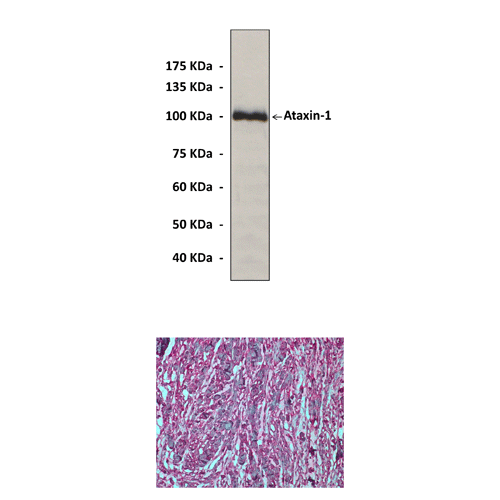Anti-Ataxin-1: Rabbit Ataxin-1 Antibody |
 |
BACKGROUND Ataxin-1 (ATXN1) is a 98 kDa protein and a member of the protein family containing polymorphic polyglutamine (polyQ) tracts related to neurodegenerative diseases. Although clinically distinct, these pathologies are all caused by a common mechanism: when the polyQ tract is anomalously expanded above a threshold which varies for each disease the polyQ carrier protein misfolds and aggregates leading to cellular death. Expansion in ATXN1 above 35–42 glutamines is associated with spinocerebellar ataxia type 1 (SCA1), an autosomal dominant neurodegenerative disorder characterized by motor coordination deficits caused by progressive loss of Purkinje cells in the cerebellar cortex and neurons in the brain stem and spinocerebellar tracts. However, it was shown that the polyglutamine tract of ATXN1 is not sufficient to cause pathogenesis but does promote the binding of regulatory proteins that increase the stability and accumulation of the mutant ATXN1.1 Two highly conserved regions outside of the polyglutamine tract in ATXN1 that have such a role are the 120 residue ATXN1/HBP1 (AXH) domain, amino acids 570-689, and a short stretch of amino acids, residues 771-778, at the C-terminus. While several transcription factors as well as RNA interact with ATXN1 via the AXH domain, the C-terminal region is of particular interest since the interaction of certain proteins with this region is impacted by length of the polyglutamine and/or phosphorylation of Ser776. Moreover, data indicate that the phosphorylation status of Ser776 has a critical role in regulating SCA1 pathogenesis. Ser776 is positioned within or immediately adjacent to three functional motifs in the C-terminus of ATXN1; the NLS - amino acids 771-774, the 14-3-3 binding site - amino acids 774-776, and the U2AF-homology ligand motif (ULM) - amino acids 771-776. The ULM in ATXN1 binds to the U2AFhomology motifs (UHM) in RBM17 and U2AF65. Moreover, as seen for other ULM/UHM interactions, phosphorylation of Ser776 in the ULM of ATXN1 seems to regulate its interaction with RBM17 and U2AF65. It was shown that Akt can phosphorylate Ser776, data also suggests that PKA is the Ser776-ATXN1 kinase in the mammalian cerebellum. In addition, it was shown that the protein phosphatase 2A (PP2A) dephosphorylation of pSer776-ATXN1 is restricted to the nucleus of cerebellar cells. Moreover, data indicate that binding of 14-3-3 to pSer776-ATXN1 is restricted to the cytoplasm and impedes the dephosphorylation of pSer776 as well as entry of ATXN1 into nuclei of cerebellar cells.2 Thus the phosphorylation and dephosphorylation of ATXN1 at Ser776 take place in separate subcellular compartments in the cerebellum. The binding of 14-3-3 to pS776-ATXN1 protects against dephosphorylation in the cytoplasm. The pSer776-ATXN1/14-3-3 complex must be disassociated in order for ATXN1 to be transported to the nucleus, implying that this disassociation is regulated. Therefore, the inhibition of phosphorylation at Ser776 has therapeutic potential for SCA1. Furthermore recent evidence shows that altered interactions of ATXN1 with its native partners contribute to SCA1 pathogenesis. Several protein interactors of ATXN1 have been identified to date. Among these, there are various transcriptional regulators, including the Capicua homolog CIC, SMRTER, HDAC3, GFI-1 and RORα.3
REFERENCES
1. Heintz, N.: Science 301:59-60, 2003
2. Lai, S. et al: J. Biol. Chem. 2011 (In press)
3. Crespo-Barreto, J. et al: PLoS Genet. 6:1001021, 2010
2. Lai, S. et al: J. Biol. Chem. 2011 (In press)
3. Crespo-Barreto, J. et al: PLoS Genet. 6:1001021, 2010
Products are for research use only. They are not intended for human, animal, or diagnostic applications.
Параметры
Cat.No.: | CY1117 |
Antigen: | A short peptide from human Ataxin-1 sequence. |
Isotype: | Rabbit IgG |
Species & predicted species cross- reactivity ( ): | Human, Mouse, Rat |
Applications & Suggested starting dilutions:* | WB 1:1000 IP n/d IHC n/d ICC n/d FACS n/d |
Predicted Molecular Weight of protein: | 98 kDa |
Specificity/Sensitivity: | Detects endogenous levels of Ataxin-1 proteins without cross-reactivity with other related proteins. |
Storage: | Store at -20°C, 4°C for frequent use. Avoid repeated freeze-thaw cycles. |
*Optimal working dilutions must be determined by end user.
Документы
Информация представлена исключительно в ознакомительных целях и ни при каких условиях не является публичной офертой








